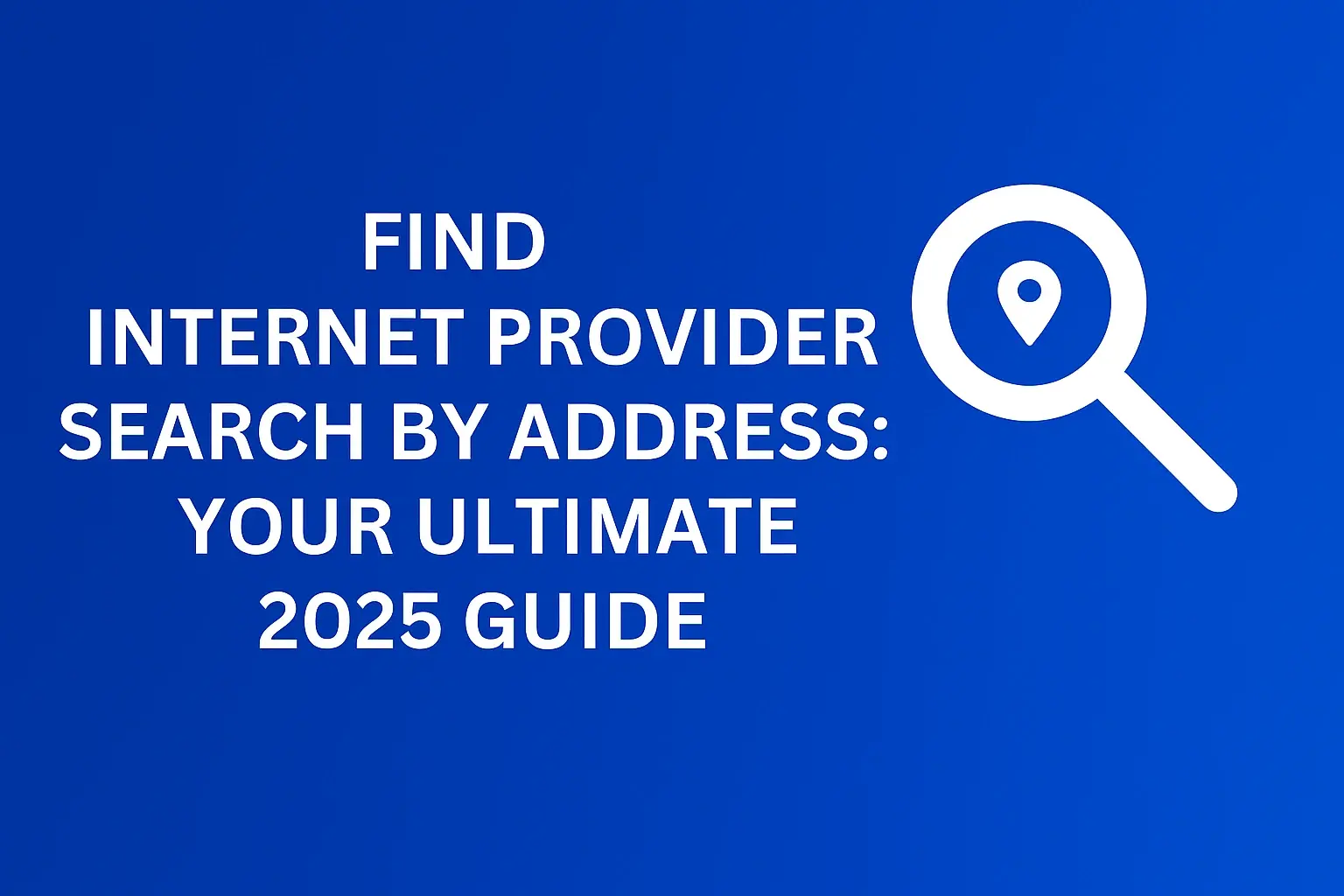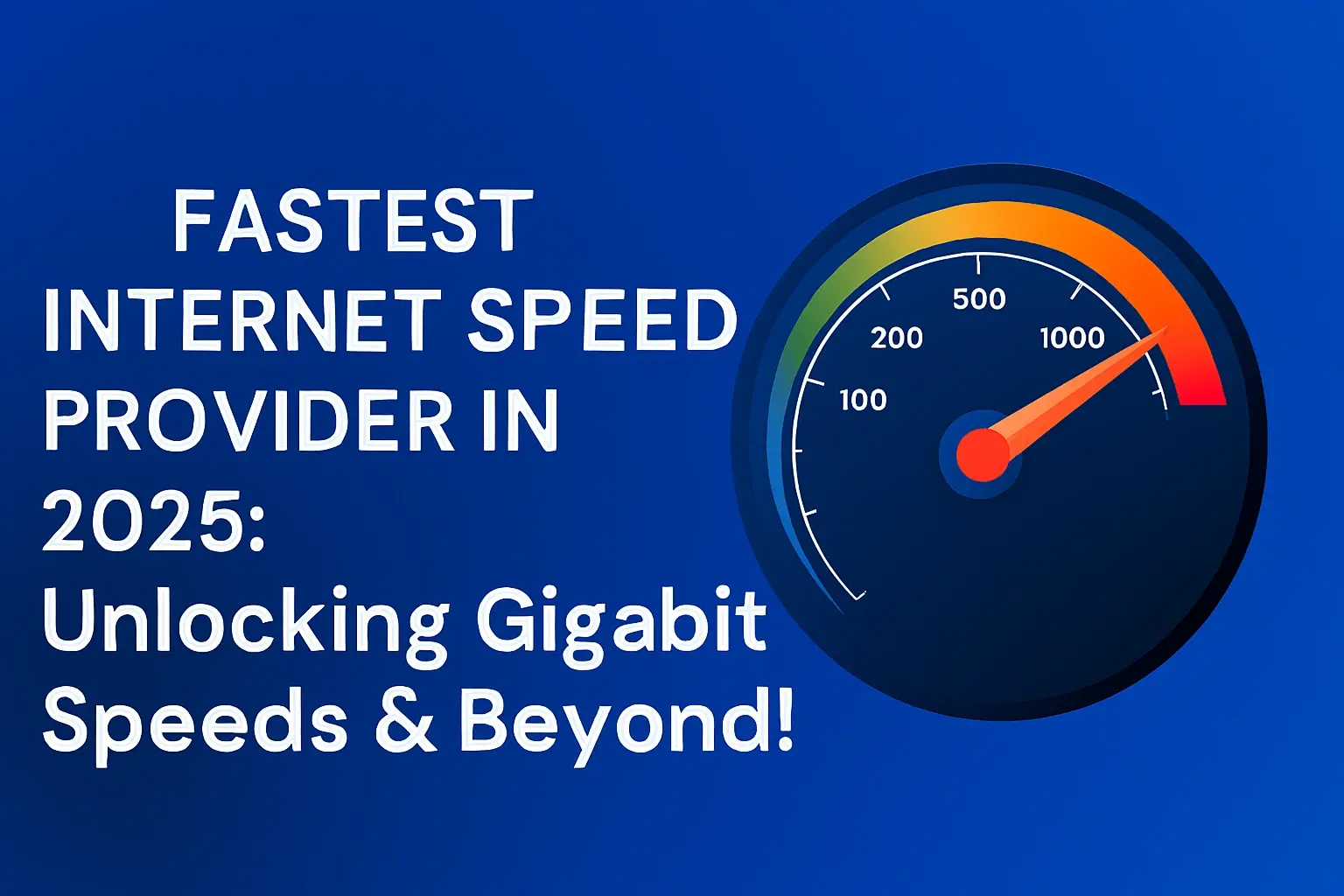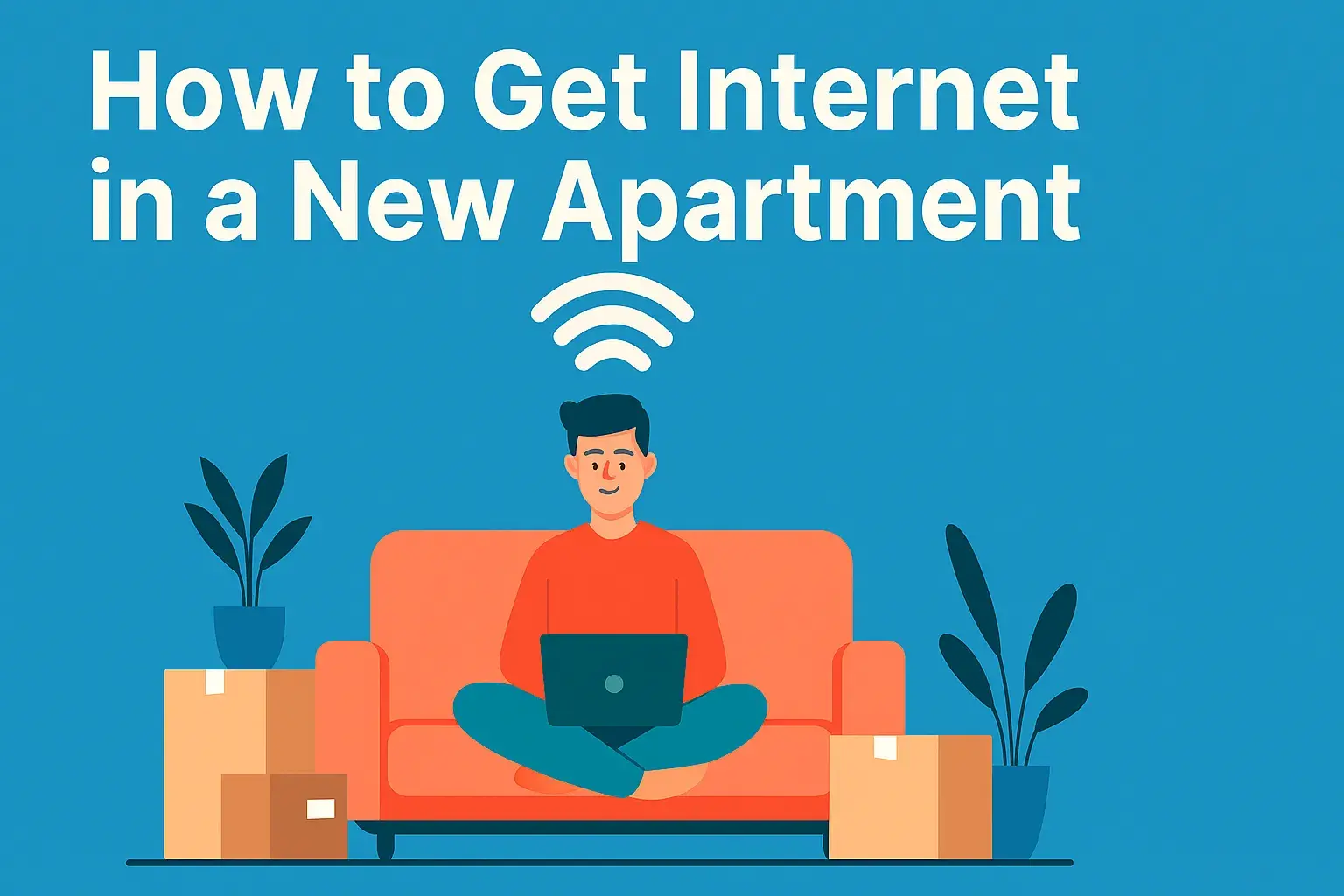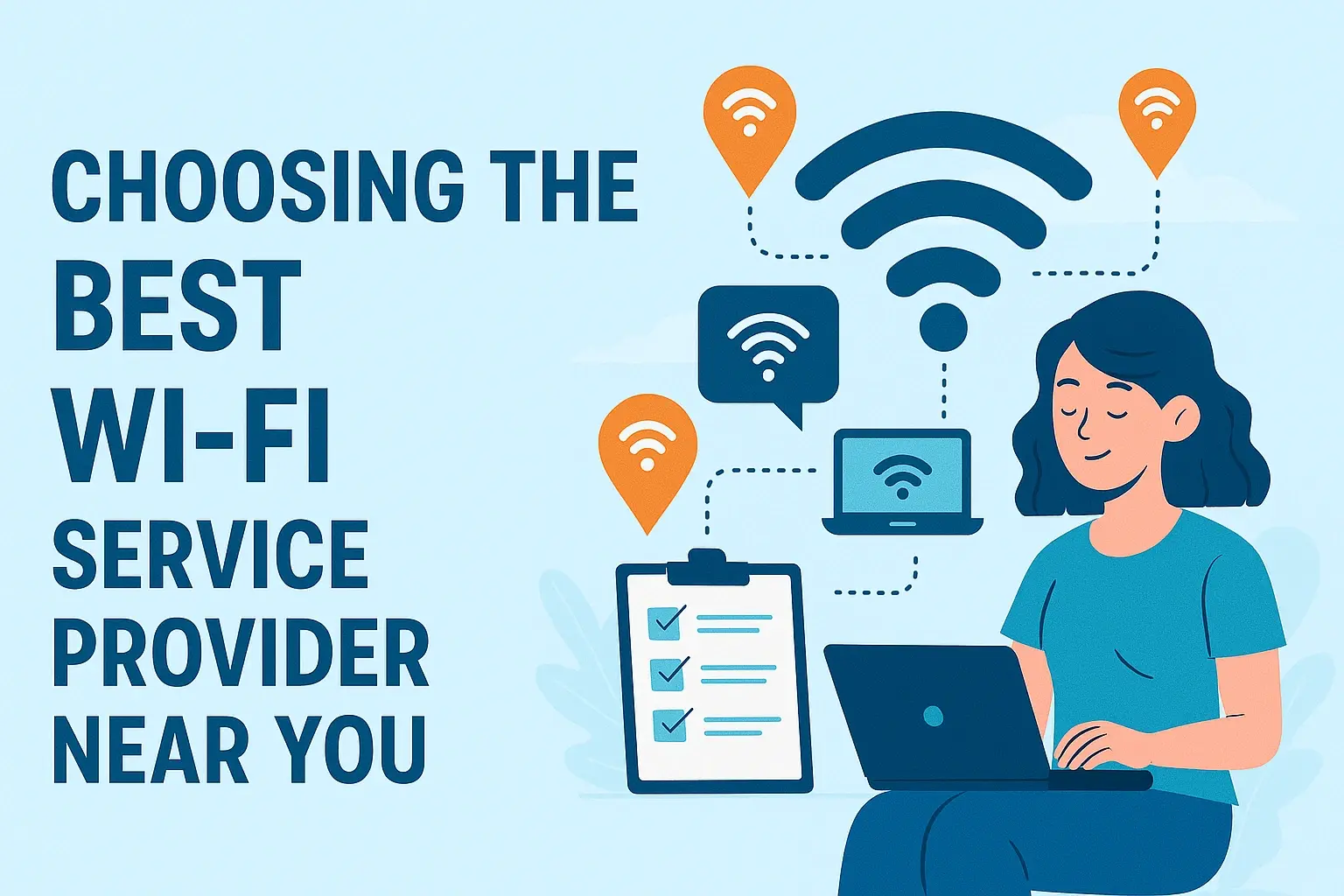Should I Switch Internet Providers: Key Factors to Consider

Deciding whether to switch internet providers can be a complex decision. This guide breaks down the essential factors to consider in 2025, from speed and cost to reliability and customer service, helping you make an informed choice for your home or business.
Understanding Your Internet Speed and Performance Needs
In 2025, internet speed is no longer a luxury; it's a necessity. Whether you're a casual browser, a remote worker, a passionate gamer, or a streaming enthusiast, your internet's performance directly impacts your daily life. Understanding your specific needs is the first crucial step in determining if a provider switch is warranted. Many users underestimate their actual bandwidth requirements, leading to frustration with buffering, slow downloads, and laggy video calls. Conversely, some might be overpaying for speeds they rarely utilize.
Assessing Your Current Usage Patterns
Before you even look at competitor offerings, take stock of how you and your household use the internet. Consider the following:
- Number of Connected Devices: How many smartphones, tablets, smart TVs, gaming consoles, smart home devices (thermostats, cameras, speakers), and computers are simultaneously connected to your network? Each device consumes bandwidth. A household with 10+ devices will have significantly higher demands than a single individual.
- Primary Online Activities:
- Web Browsing & Email: These are relatively low-bandwidth activities, typically requiring 5-10 Mbps.
- Streaming Video: Standard definition (SD) requires around 3-5 Mbps, HD (1080p) needs 5-8 Mbps, and 4K Ultra HD demands 25 Mbps or more per stream. If multiple people are streaming simultaneously, these numbers multiply.
- Online Gaming: While download speeds are important for game updates (often 50 Mbps+ for large titles), latency (ping) is critical for real-time gameplay. Lower ping means less lag. Many gamers benefit from speeds of 50-100 Mbps and low latency connections.
- Video Conferencing: For smooth, reliable video calls (e.g., Zoom, Google Meet), aim for at least 10-20 Mbps download and 5-10 Mbps upload. High-definition video calls will require more.
- Large File Downloads/Uploads: Professionals working with large design files, video editors, or those frequently backing up to cloud storage will need significant download and upload speeds. Upload speed is often the bottleneck for these tasks.
- Smart Home Devices: While individual smart home devices use minimal bandwidth, a large ecosystem can contribute to network congestion, especially if they are constantly communicating.
- Number of Users: More users mean more simultaneous activities, compounding bandwidth needs.
Understanding Speed Metrics: Mbps and Gbps
Internet speeds are measured in megabits per second (Mbps) and gigabits per second (Gbps). A gigabit is 1,000 megabits.
- Download Speed: This is the speed at which your device receives data from the internet. It's crucial for streaming, browsing, and downloading files.
- Upload Speed: This is the speed at which your device sends data to the internet. It's vital for video conferencing, uploading files to cloud storage, online gaming, and live streaming. Many residential plans have asymmetrical speeds, meaning download speeds are much higher than upload speeds.
Recommended Speeds for Common Scenarios (2025 Estimates)
Here’s a general guideline for recommended speeds, assuming multiple users and devices in a household:
| Activity/Scenario | Recommended Download Speed (Mbps) | Recommended Upload Speed (Mbps) |
|---|---|---|
| Basic Browsing & Email (1-2 users) | 15-25 | 3-5 |
| HD Streaming & Casual Use (2-4 users) | 50-100 | 10-20 |
| 4K Streaming, Online Gaming, Video Calls (4+ users, multiple devices) | 100-300 | 20-50 |
| Heavy Uploads (Video editing, cloud backup) | 300+ | 50-100+ |
| Gigabit Connection (Future-proofing, power users) | 1000+ | 1000+ |
Many providers now offer gigabit internet (1000 Mbps or more). While this might seem like overkill for some, it's becoming increasingly valuable for households with a high density of connected devices and demanding activities. If your current provider offers significantly slower speeds than your needs dictate, or if you're experiencing constant slowdowns despite having a seemingly adequate plan, it's a strong indicator that switching might be beneficial. Look for providers that offer symmetrical speeds (equal download and upload) if your work or hobbies demand heavy uploads.
Analyzing Cost and Value: Beyond the Monthly Bill
The monthly price is often the most visible factor when considering an internet provider switch. However, focusing solely on the sticker price can lead to a decision that isn't truly cost-effective in the long run. True value comes from balancing speed, reliability, features, and customer service against the total cost of ownership.
Understanding Pricing Structures
Internet pricing can be complex. Be aware of:
- Promotional vs. Standard Rates: Many providers offer attractive introductory rates for the first 6-12 months. It's crucial to know what the price will jump to after the promotional period ends.
- Bundling Discounts: Providers often offer discounts when you bundle internet with TV, phone, or mobile services. Evaluate if these bundles truly offer savings or if you're paying for services you don't need.
- Tiered Pricing: Plans are typically tiered based on speed. Higher speeds cost more.
Calculating True Cost of Ownership
To assess the real value, consider these additional costs and factors:
- Equipment Rental Fees: Most providers charge a monthly fee for modem and router rentals. These fees can add up significantly over time. Purchasing your own compatible modem and router can often save you money. Check your provider's compatibility list and warranty information before buying.
- Installation Fees: Some providers charge an upfront fee for professional installation. Negotiate this or see if self-installation is an option.
- Data Caps: While less common for fixed-line broadband in many regions, some plans (especially satellite or fixed wireless) have data caps. Exceeding these caps can result in throttling or hefty overage charges. Understand your typical monthly data usage and compare it against plan limits. You can usually find this information in your current provider's account portal.
- Contract Length: Longer contracts might offer lower monthly rates but lock you in. Shorter contracts offer flexibility but might have higher standard rates.
- Performance vs. Price: Is the cheapest plan fast enough for your needs? Conversely, are you paying a premium for speeds you rarely utilize? The sweet spot is finding a plan that meets your performance requirements at a reasonable price point.
Comparing Value Propositions
When comparing providers, create a spreadsheet to track key metrics:
| Provider | Advertised Speed (Download/Upload) | Monthly Price (Promotional) | Monthly Price (After Promo) | Equipment Fee (Monthly) | Installation Fee | Data Cap | Contract Length | Estimated Annual Cost (Year 2+) |
|---|---|---|---|---|---|---|---|---|
| Current Provider | [Your Current Speed] | [Your Current Price] | [Your Current Price] | [Your Current Equipment Fee] | N/A | [Your Current Data Cap] | [Your Current Contract Status] | [Calculate] |
| Provider A | [Speed] | [Price] | [Price] | [Fee] | [Fee] | [Cap] | [Length] | [Calculate] |
| Provider B | [Speed] | [Price] | [Price] | [Fee] | [Fee] | [Cap] | [Length] | [Calculate] |
This comparison helps you see the long-term financial implications. A slightly higher monthly cost for a significantly faster or more reliable connection, with no equipment fees, might represent better value than a cheaper plan with hidden costs and slower speeds. In 2025, the increasing demand for bandwidth means that investing in a plan that adequately meets your needs, even if it's not the absolute cheapest, will likely provide better overall value and fewer headaches.
Availability and Technology: What's Actually Possible in Your Area?
One of the most significant limiting factors when choosing an internet provider is what's actually available at your specific address. The type of internet technology deployed in your neighborhood dictates the speeds, reliability, and even the providers you can consider. It's essential to understand these options and verify availability before getting your hopes set on a particular plan.
Understanding Different Internet Technologies
The primary types of broadband internet available in 2025 include:
- Fiber Optic (FTTH/FTTP): This is the gold standard for internet connectivity. Fiber optic cables transmit data using light signals, offering incredibly high speeds (often symmetrical Gigabit and beyond), low latency, and exceptional reliability. If fiber is available in your area, it's almost always the best option. It's also the most future-proof technology.
- Cable Internet: This technology uses the same coaxial cable infrastructure as cable television. It offers good download speeds, often reaching hundreds of Mbps, but upload speeds are typically much lower (asymmetrical). Cable networks are shared, meaning performance can sometimes degrade during peak usage hours in densely populated areas.
- DSL (Digital Subscriber Line): DSL uses existing telephone lines to transmit data. Speeds vary significantly based on the distance from the telephone company's central office. It's generally slower than cable or fiber, with speeds ranging from a few Mbps to around 100 Mbps in ideal, short-distance scenarios. Upload speeds are also very limited.
- Fixed Wireless: This technology uses radio waves to connect a fixed location (your home or business) to a nearby tower. It's often used in rural or suburban areas where laying cable is cost-prohibitive. Speeds can vary widely depending on the provider, tower proximity, and line of sight. It can be a viable alternative to DSL in some areas but is generally less reliable than cable or fiber.
- Satellite Internet: This is typically the only option for extremely remote locations. It involves a satellite dish on your property communicating with a satellite in orbit. While it offers wide availability, satellite internet is known for high latency, lower speeds, and often strict data caps, making it unsuitable for real-time applications like gaming or heavy streaming. Providers like Starlink are improving latency and speeds, making it a more competitive option in some underserved areas.
- 5G Home Internet: Mobile carriers are increasingly offering home internet services using their 5G cellular networks. This can be a competitive option, especially in areas with strong 5G coverage, offering speeds comparable to cable or even lower-end fiber plans. Availability is expanding rapidly.
How to Check Availability
The most direct way to check availability is to visit the websites of major internet service providers (ISPs) and enter your full street address. Reputable providers will have an availability checker. Don't rely solely on general coverage maps, as availability can vary block by block.
- ISP Websites: Go to the "Internet," "Shop Plans," or "Check Availability" sections of provider websites (e.g., Verizon, AT&T, Spectrum, Xfinity, T-Mobile Home Internet, Starlink).
- Third-Party Comparison Sites: Many websites aggregate ISP offerings and allow you to check availability by address. Use these as a starting point, but always verify on the ISP's official site.
- Ask Your Neighbors: Sometimes, the best indicator is what your neighbors are using and their satisfaction levels.
Bridging the Digital Divide
The availability of high-speed internet remains a significant issue, particularly in rural and underserved urban areas. If you're in such a situation, your options might be limited. In 2025, government initiatives and private investments are working to expand fiber and 5G networks, so it's worth re-checking availability periodically.
If you have multiple technology options (e.g., both cable and fiber), prioritize them in this order:
- Fiber Optic
- 5G Home Internet (if speeds and reliability are competitive)
- Cable Internet
- Fixed Wireless
- DSL
- Satellite Internet (as a last resort)
Understanding the technology available to you is fundamental. You can't switch to a service that doesn't exist at your address. This knowledge will help you set realistic expectations and focus your search on the most viable providers and plans.
Reliability and Uptime: The Unsung Heroes of Connectivity
Speed is important, but what happens when your internet connection is consistently dropping or unavailable? Reliability and uptime are critical, especially for those who depend on their internet for work, education, or essential communication. A provider might offer blazing-fast speeds on paper, but if the service is frequently interrupted, it’s effectively useless.
What is Uptime?
Uptime refers to the percentage of time a network or service is operational and accessible. For internet providers, a high uptime percentage means fewer outages. While 100% uptime is practically impossible for any complex system, industry standards for reliable broadband are typically 99.9% or higher.
Let's break down what that means:
- 99.9% Uptime: Approximately 8.76 hours of downtime per year.
- 99.99% Uptime: Approximately 52.56 minutes of downtime per year.
- 99.999% Uptime: Approximately 5.26 minutes of downtime per year.
For most residential users, 99.9% might be acceptable, but for businesses or remote workers, higher uptime guarantees are essential. Some providers offer Service Level Agreements (SLAs) that guarantee a certain uptime percentage and may offer credits if they fail to meet it. These are more common for business plans but worth inquiring about.
Factors Affecting Reliability
Several factors can influence the reliability of your internet connection:
- Infrastructure Quality: The age and maintenance of the physical network infrastructure (fiber optic cables, coaxial cables, cell towers) play a huge role. Older, poorly maintained networks are more prone to issues.
- Network Congestion: As mentioned earlier, shared networks (like cable) can experience slowdowns or intermittent drops during peak usage times when many users are online simultaneously.
- Equipment Issues: Faulty modems, routers, or network interface cards (NICs) in your devices can cause connection problems.
- Environmental Factors: For fixed wireless and satellite, severe weather (heavy rain, snow, storms) can disrupt signals.
- Power Outages: While not directly an ISP issue, widespread power outages will naturally affect internet service if your modem/router and the ISP's local equipment lose power.
- Maintenance and Upgrades: ISPs periodically perform maintenance or upgrades that can cause brief, scheduled outages. Reputable providers usually give advance notice for these.
How to Gauge Reliability Before Switching
Assessing reliability can be tricky, as it's not always advertised like speed. Here are some strategies:
- Online Reviews and Forums: Search for reviews of ISPs in your specific area. Look for recurring complaints about outages or connectivity issues. Websites like Reddit (e.g., r/Internet, local city subreddits) often have candid discussions.
- Ask Your Neighbors: This is invaluable. Ask people on your block or in your building about their experiences with different providers, specifically mentioning reliability.
- Check Outage Maps: Some providers have public outage maps, but these are often for current, widespread issues rather than chronic local problems.
- Service Level Agreements (SLAs): For business-grade services, look for providers offering SLAs. While not typical for residential plans, it indicates a commitment to uptime.
- Trial Periods: If a provider offers a risk-free trial period, take advantage of it to test their reliability in real-world conditions.
The Trade-off Between Price and Reliability
Often, the cheapest plans are not the most reliable. Providers that invest heavily in robust infrastructure and network management tend to charge more. If your work or critical activities depend on a stable connection, it might be worth paying a bit more for a provider known for its uptime, especially if your current service is frequently unreliable. Fiber optic connections are generally considered the most reliable technology due to their dedicated nature and resistance to interference.
Customer Service and Support: Your Lifeline When Things Go Wrong
Even with the best internet technology and speeds, issues can arise. When they do, the quality of customer service and technical support can make the difference between a minor inconvenience and a major headache. In 2025, with more people relying on home internet for work and life, responsive and effective support is more crucial than ever.
What to Look for in Customer Service
Consider these aspects when evaluating a provider's support:
- Availability: Are they available 24/7? What channels can you use to contact them (phone, chat, email, social media)? Long hold times or limited support hours can be incredibly frustrating.
- Responsiveness: How quickly do they respond to inquiries? Are their chat agents or phone support staff knowledgeable and efficient?
- Technical Expertise: Can their support staff effectively diagnose and resolve technical issues? Do they have tiered support levels, or will you be stuck with a script reader?
- Problem Resolution: Do they actually fix the problems, or do they offer temporary workarounds? What is their process for escalating complex issues?
- Clarity and Transparency: Do they explain issues clearly? Are they upfront about outages or maintenance?
- Online Resources: Do they offer a comprehensive FAQ, knowledge base, or community forums where you can find answers yourself?
How to Research Customer Service Quality
Gathering information about customer service can be challenging, as providers aim to present a positive image. Here's how to get a more realistic picture:
- Online Reviews: Websites like Trustpilot, Better Business Bureau (BBB), and consumer review sites often have sections dedicated to customer service. Look for patterns in complaints or praise.
- Social Media: Search for the provider's name on platforms like X (formerly Twitter) or Facebook. You can often see how they interact with customers publicly, including how they handle complaints.
- Consumer Reports: Organizations like Consumer Reports often conduct surveys on ISP customer satisfaction and reliability.
- Ask Your Neighbors: Again, direct feedback from people in your community is invaluable. Ask them about their experiences with support calls or online chat.
- Your Own Experience: If you're currently with a provider, reflect on your past interactions. Were they helpful? Did they resolve your issues?
The Cost of Poor Support
Poor customer service can lead to:
- Lost Productivity: If your internet is down and support is unresponsive, you can't work or study.
- Increased Stress: Dealing with unhelpful support agents is a common source of frustration.
- Unnecessary Expenses: If issues aren't resolved promptly, you might continue paying for a service that isn't working correctly.
When comparing providers in 2025, don't overlook this crucial aspect. A provider with slightly lower speeds but excellent, responsive customer support might offer a better overall experience than a faster provider with notoriously bad service. For critical users, investing in a provider known for its support infrastructure is often a wise decision.
Contract Terms, Fees, and Hidden Costs
Beyond the advertised monthly price, internet providers often have a web of contract terms, fees, and potential hidden costs that can significantly impact the total expense and your flexibility. Understanding these details is vital to avoid unwelcome surprises and ensure you're not locked into a bad deal.
Deconstructing Contract Terms
Most residential internet plans in 2025 are either month-to-month or require a contract, typically for 12 or 24 months. Each has pros and cons:
- Month-to-Month Plans:
- Pros: Maximum flexibility. You can cancel or switch providers at any time without early termination fees (ETFs).
- Cons: Often have higher standard monthly rates compared to contract plans. May not be eligible for certain promotional pricing.
- Contract Plans (12-24 Months):
- Pros: Typically offer lower monthly rates and may include promotional discounts for the duration of the contract.
- Cons: You are legally obligated to pay for the service for the entire contract term. Early termination can result in substantial ETFs, often ranging from $100 to $300 or more.
Key Contract Considerations:
- Early Termination Fees (ETFs): Understand the exact amount and how it's prorated if you cancel before the contract ends.
- Automatic Renewals: Some contracts automatically renew if you don't cancel within a specific window before the term ends.
- Price Guarantees: Does the provider guarantee the price for the entire contract term, or can it increase?
Uncovering Hidden Fees
These are charges that might not be immediately obvious or are buried in the fine print:
- Equipment Rental Fees: As mentioned, modems and routers are often leased for a monthly fee ($10-$20+). Purchasing your own can save money long-term.
- Installation Fees: Professional installation can cost anywhere from $50 to $200+. Some providers offer free installation as a promotion or allow for self-installation to avoid this fee.
- Activation Fees: A one-time fee to set up your service.
- Service Call Fees: If a technician needs to visit your home to fix an issue, you might be charged if the problem is deemed to be with your equipment or inside wiring (and not the provider's fault).
- Late Fees: Standard fees for missed payments.
- Taxes and Surcharges: These vary by location and can add a significant percentage to your bill.
Data Caps and Overage Charges
While less common for fiber and cable in many regions, data caps are still prevalent with satellite, fixed wireless, and sometimes DSL plans. Be absolutely certain of your data cap and the cost of exceeding it. For example, a $60/month plan with a 1TB data cap could become a $160+ month if you consistently go over, especially if there are per-GB overage charges.
How to Avoid Surprises
- Read the Fine Print: Always review the service agreement and terms of service before signing up.
- Ask Direct Questions: Don't be afraid to ask the sales representative about all potential fees, contract terms, and price increases. Get answers in writing if possible.
- Use Comparison Tools: Utilize comparison websites and create your own spreadsheet to compare the total estimated annual cost, including all fees, not just the advertised monthly rate.
- Consider Month-to-Month: If flexibility is paramount and you're unsure about a provider's long-term performance, a month-to-month plan might be worth the slightly higher monthly cost.
- Negotiate: Don't be afraid to negotiate prices, especially if you have competing offers or are a long-time customer considering leaving.
In 2025, transparency is key. Providers who are upfront about all costs and terms are generally more trustworthy. Be wary of offers that seem too good to be true without clear explanations of what's included and what isn't.
Future-Proofing Your Connection: Planning for Tomorrow's Needs
The internet landscape is constantly evolving. What seems like a cutting-edge speed today might be standard tomorrow. When considering a switch, it's wise to think about your future needs and choose a provider and plan that can accommodate them, rather than having to switch again in a year or two.
The Accelerating Demand for Bandwidth
Several trends are driving the increasing demand for internet bandwidth:
- Higher Resolution Streaming: 4K and even 8K video streaming are becoming more common, requiring significantly more bandwidth than HD.
- Growth of Smart Homes: The proliferation of smart devices – cameras, thermostats, speakers, appliances – all connect to your network and contribute to overall usage.
- Virtual and Augmented Reality (VR/AR): As VR/AR technologies mature and become more accessible, they will demand high bandwidth and low latency for immersive experiences.
- Remote Work and Education: The shift towards remote work and online learning means more people are relying on stable, high-speed internet for video conferencing, cloud access, and collaborative tools.
- Cloud Computing: More applications and data are moving to the cloud, requiring faster download and upload speeds for seamless access.
- Gaming Advancements: Modern online games are massive, and cloud gaming services are emerging, both requiring substantial bandwidth.
Choosing a Plan with Room to Grow
When evaluating new plans, consider these future-proofing aspects:
- Speed Tiers: If you're considering a 100 Mbps plan, but gigabit is available and only slightly more expensive, it might be worth the investment. Look for plans that offer a significant jump in speed from your current service, giving you headroom for future demands.
- Upload Speeds: As mentioned, upload speeds are becoming increasingly important for video conferencing, cloud backups, and content creation. Symmetrical or near-symmetrical speeds (like those offered by fiber) are the best for future-proofing.
- Technology Type: Fiber optic is inherently future-proof due to its massive capacity. If fiber is available, it's the most robust long-term investment. 5G home internet also has significant future potential as networks are upgraded.
- Provider's Network Investment: Research whether the provider is actively investing in upgrading its network infrastructure in your area. Providers with a commitment to ongoing development are more likely to offer faster speeds and better technology in the future.
The Cost of Future-Proofing
While future-proofing might mean a slightly higher upfront cost, it can save you money and hassle in the long run by avoiding frequent service changes. The cost of switching providers – installation fees, potential ETFs with your old provider, and the time spent researching and setting up – can add up.
In 2025, the trend is clear: internet usage will only continue to grow. Opting for a plan that significantly exceeds your current needs, especially in terms of speed and upload capacity, is a strategic decision that can pay dividends for years to come. It ensures you're not constantly battling slow speeds or buffering as new technologies and applications emerge.
Making the Switch: A Step-by-Step Guide
Decided it's time for a change? Congratulations on taking a proactive step towards better internet! Here’s a practical, step-by-step guide to ensure a smooth transition from your old provider to your new one.
Step 1: Research and Compare Thoroughly
This is the most critical phase. Use the factors discussed throughout this guide:
- Identify Needs: Determine your required speeds, data usage, and essential features.
- Check Availability: Use provider websites and third-party tools to see what's available at your address.
- Compare Plans: Look at speeds, upload/download ratios, pricing (promotional and standard), contract terms, equipment fees, and data caps.
- Read Reviews: Focus on reliability and customer service in your specific geographic area.
Step 2: Understand Your Current Contract
Before committing to a new provider, check your current contract:
- Contract End Date: Are you nearing the end of your term?
- Early Termination Fees (ETFs): Calculate the cost of breaking your contract if necessary. Sometimes, the savings from a new provider outweigh the ETF.
- Notice Period: Some contracts require you to give 30 days' notice before canceling.
Step 3: Choose Your New Provider and Plan
Based on your research, select the provider and plan that best fits your needs and budget. Be sure to:
- Confirm All Costs: Ask for a breakdown of all monthly charges, one-time fees, and equipment costs.
- Get It in Writing: If possible, get the details of your chosen plan and pricing in writing or via email confirmation.
Step 4: Schedule Installation and Service Activation
Once you've signed up:
- Book Installation: Schedule an installation appointment. If self-installation is an option and you're comfortable with it, you might save on fees and get service faster.
- Purchase Equipment (Optional): If you plan to use your own modem/router, ensure it's compatible with the new provider and purchase it in advance.
Step 5: Prepare for the Switch Day
On or around your switch date:
- Keep Current Service Active: Do NOT cancel your old service until your new service is fully installed and working. This prevents an internet outage during the transition.
- Clear Space: Ensure the installation area is accessible for the technician.
- Test Your New Equipment: If self-installing, follow the instructions carefully.
Step 6: Install and Test New Service
When the technician arrives or you begin self-installation:
- Follow Instructions: Connect your modem and router.
- Activate Service: You may need to call the provider or follow an online activation process.
- Run Speed Tests: Use reputable speed test websites (e.g., Speedtest.net, Fast.com) to verify you're getting the speeds you're paying for. Test at different times of the day.
- Test Key Applications: Try streaming video, making a video call, or playing an online game to ensure performance.
Step 7: Cancel Your Old Service
Once you're confident your new service is stable and performing well:
- Contact Your Old Provider: Officially cancel your service.
- Return Equipment: Arrange to return any leased equipment to your old provider to avoid unreturned equipment fees. Follow their instructions for shipping or drop-off.
- Confirm Cancellation: Get confirmation of your cancellation, ideally in writing.
Step 8: Monitor and Troubleshoot
Keep an eye on your new service for the first few weeks:
- Ongoing Speed Tests: Continue to monitor speeds and reliability.
- Review Your First Bill: Ensure all charges are accurate and match what you were quoted.
- Contact Support If Needed: If you experience any issues, don't hesitate to contact your new provider's customer support.
Switching internet providers can seem daunting, but by following these steps and doing your homework, you can ensure a seamless transition to a service that better meets your needs in 2025 and beyond.
Conclusion
The decision of whether to switch internet providers in 2025 hinges on a careful evaluation of your current service versus available alternatives. By meticulously assessing your speed and performance needs, analyzing the true cost and value beyond monthly bills, understanding technology availability, prioritizing reliability and customer support, scrutinizing contract terms, and considering future-proofing, you can make an informed choice. Don't settle for subpar service; proactive research and comparison are your best tools. Take the time to weigh these key factors, and you'll be well-equipped to find an internet provider that delivers the speed, reliability, and value you deserve, ensuring seamless connectivity for all your digital activities.





